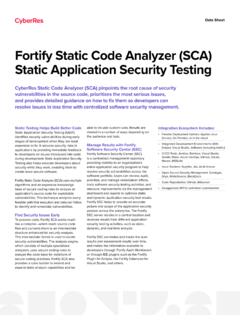Transcription of Certified LabVIEW Developer (CLD) Certification and ... - NI
1 100900A-01 Certified LabVIEW Developer (CLD) Certification and Exam Overview 2012 National Instruments Corp. All rights reserved Page 1 of 13 Certification Overview The National Instruments LabVIEW Certification Program consists of the following three Certification levels: 1. Certified LabVIEW Associate Developer (CLAD) 2. Certified LabVIEW Developer (CLD) 3. Certified LabVIEW Architect (CLA) Each level is a prerequisite for the next level of Certification . The CLAD Certification is a prerequisite to taking the CLD exam. The CLD Certification is a prerequisite to taking the CLA exam. There are no exceptions to the requirements for each exam. A CLAD demonstrates a broad and complete understanding of the core features and functionality available in the LabVIEW Full Development System and possesses the ability to apply that knowledge to develop, debug, and maintain small LabVIEW modules. The typical experience level of a CLAD is approximately 6 to 9 months in the use of the LabVIEW Full Development System.
2 A CLD demonstrates experience in developing, debugging, and deploying and maintaining medium-to-large scale LabVIEW applications. A CLD is a professional with cumulative experience of approximately 12 to 18 months developing medium to large applications in LabVIEW . A CLA demonstrates mastery in architecting LabVIEW applications for a multi- Developer environment. A CLA not only possesses the technical expertise and software development experience to break a project specification into manageable LabVIEW components, but also has the experience to see the project through by effectively utilizing project and configuration management tools. A CLA is a professional with a cumulative experience of approximately 24 months in developing medium to large applications in LabVIEW . 100900A-01 Certified LabVIEW Developer (CLD) Certification and Exam Overview 2012 National Instruments Corp. All rights reserved Page 2 of 13 Exam Overview Your test computer will have the LabVIEW Full Development System version 2011 or later installed for developing your application.
3 After October 1, 2012, LabVIEW 2012 may be installed. Contact your proctor or testing center prior to the exam to get additional details and familiarize yourself with the specific LabVIEW version that will be used to develop your application. You may request the proctor to allow you a few minutes before your exam to customize the LabVIEW environment for your needs or to familiarize yourself with the environment. The proctor will only hand over the exam when you are ready to begin working on the exam. Please note that you will not receive extra time for the exam to compensate for unfamiliarity with the LabVIEW environment. Refer to LabVIEW Development Systems comparison for details about LabVIEW Full Development System features. Exam Duration: 4 hours Style of exam: Practical application development Passing grade: 70% The exam validates problem solving skills, knowledge, and experience in the development of measurement and automation applications using LabVIEW .
4 The exam involves software development only and does not involve any hardware. The use of resources available in LabVIEW , such as the LabVIEW Help, examples, and templates are allowed during the exam. Externally developed VIs or resources are prohibited. The exam packet will include a USB memory stick with a VI and controls in a folder hierarchy that you must use to develop you application. You must not rename the main VI, provided components, or alter the folder hierarchy. All your development VIs and controls must be saved in the provided folder hierarchy. A detailed application specification will be provided. The specifications consist of general and technical requirements for the application. You must not detach the binding staple, copy, or reproduce any section of the exam document. Failure to comply will result in failure. After you have completed your exam, you must transfer the solution to the provided USB memory stick. Please validate the copied solution on the USB stick before returning it to your proctor.
5 You must not detach the binding staple, copy, or reproduce any section or solution of the exam. Failure to comply will result in failure. 100900A-01 Certified LabVIEW Developer (CLD) Certification and Exam Overview 2012 National Instruments Corp. All rights reserved Page 3 of 13 Exam Topics 1. Design Concepts 2. User Interface Design 3. Block Diagram Layout and Style 4. programming Practices 5. SubVI Design Practices 6. Architecture Selection 7. Timing 8. Error Handling 9. Documentation 10. Testing 100900A-01 Certified LabVIEW Developer (CLD) Certification and Exam Overview 2012 National Instruments Corp. All rights reserved Page 4 of 13 Exam Topics (Overview) Topic Subtopic 1. Design Concepts a. Modularity, scalability, readability, and maintainability b. Cohesion and coupling c. Hierarchical design d. File structure 2. User Interface (front panel window) Design Practices a. Coloring scheme b. Grouping and aligning objects c.
6 Setting properties d. Customizing objects e. State management i. Static or dynamic ii. At initialization and application stop f. Icon design 3. Block Diagram Design Practices a. data flow b. Enhancing readability 4. programming Practices a. data elements b. Functions and subVIs c. programming structures d. data structures e. References, Property Nodes 5. SubVI Design Practices a. Modularity and cohesion b. Front panel layout c. Connector pane and icon 6. Design Pattern Selection a. Scalability and maintainability b. Responsive and non-blocking c. Design patterns: i. Simple state machine ii. User interface event handler iii. Queued message handler iv. Producer/consumer ( data ) v. Producer/consumer (events) vi. Functional global variable 7. Timing a. Timing functions b. Timing mechanisms i. Event structure timeout ii. Synchronization function timeout iii. Timed structures c. Timing Express VIs and functional global variables 8. Errors a. Error handling b.
7 Error reporting 9. Documentation a. Front panel window b. Block diagram c. VI Properties 10. Testing a. Code and documentation review b. Functionality d. Errors 100900A-01 Certified LabVIEW Developer (CLD) Certification and Exam Overview 2012 National Instruments Corp. All rights reserved Page 5 of 13 CLD Topics Details 1. Design Concepts a. Modularity, scalability, readability, and maintainability 1. Develop a LabVIEW application (VI) that is: a) Modular VI functionality is subdivided into modules or subVIs b) Scalable VI requires little or no change to the user interface or block diagram to handle larger data sets or additional program states c) Readable VI conveys information about itself through good documentation and programming style d) Maintainable VI facilitates modifications without changing the original intent of the module or application b. Cohesion and coupling 1. Develop LabVIEW modules that are: a) Highly cohesive module has a clearly defined and published goal b) Loosely coupled module minimizes dependency on other modules for completing or complementing its functionality c.
8 Hierarchical design 1. Develop a LabVIEW VI that utilizes the preceding techniques to create a logical hierarchical design d. File structure 1. Organize the VIs in the file system to reflect the hierarchical nature of the software 2. Create a folder for the application and give it a relevant name 3. Make the main (top-level) VI accessible in the application folder 4. Create separate folders for subVIs and controls 2. User Interface (front panel) Design Practices a. Coloring scheme 1. Design the user interface of a VI using a consistent system coloring scheme 2. Use pastel colors where needed and avoid the use of bright colors 3. Use guidelines from the LabVIEW Style Checklist topic of the LabVIEW Help for coloring schemes of background and user interface objects b. Grouping and aligning objects 1. Group user interface objects that are logically related by using arrays, clusters, or decorations 2. Align objects and their labels to provide a uniform and consistent layout c.
9 Setting properties 1. Choose appropriate settings for the front panel object to improve usability and performance d. Customizing objects 1. Change the cosmetic appearance of a front panel window object 2. Extend application scalability by creating a type definition or strict type definition of a custom control 100900A-01 Certified LabVIEW Developer (CLD) Certification and Exam Overview 2012 National Instruments Corp. All rights reserved Page 6 of 13 e. State management 1. Set the value or attributes of a control by statically using the property dialog box of an object, or dynamically using Property Nodes 2. Initialize or set control values at application, load, start, and stop f. Icon design 1. Design main (top-level) VI and subVI icons to represent the application or module functionality 2. Maintain a consistent and uniform icon design scheme between main and subVIs 3. Block Diagram Design Practices a. data flow 1. Enforce data flow by using error terminals on VIs and Property Nodes 2.
10 Enforce data flow by using Sequence structures for VIs / functions that do not have error terminals b. Enhancing readability 1. Develop block diagrams to fit a screen resolution of 1024 x 768 2. Limit block diagram size so that a user has to scroll in only one direction 3. Evenly space VIs and functions avoid crowding too many VIs or functions in a small area 4. Evenly align VIs and functions using a consistent scheme 5. Avoid wire bends and keep the wires as straight as possible 6. Connect wires so that they appear to be connected to the correct terminals 7. Wire VIs and functions to follow left-to-right and top-to-bottom data flow 8. Avoid wiring under structures or under structure borders 9. Avoid overlapping of tunnels on structure borders 10. Avoid using colors to distinguish between block diagram sections use system colors only if needed 4. programming Practices a. data elements 1. Use appropriate data types for controls, indicators, and constants 2.






